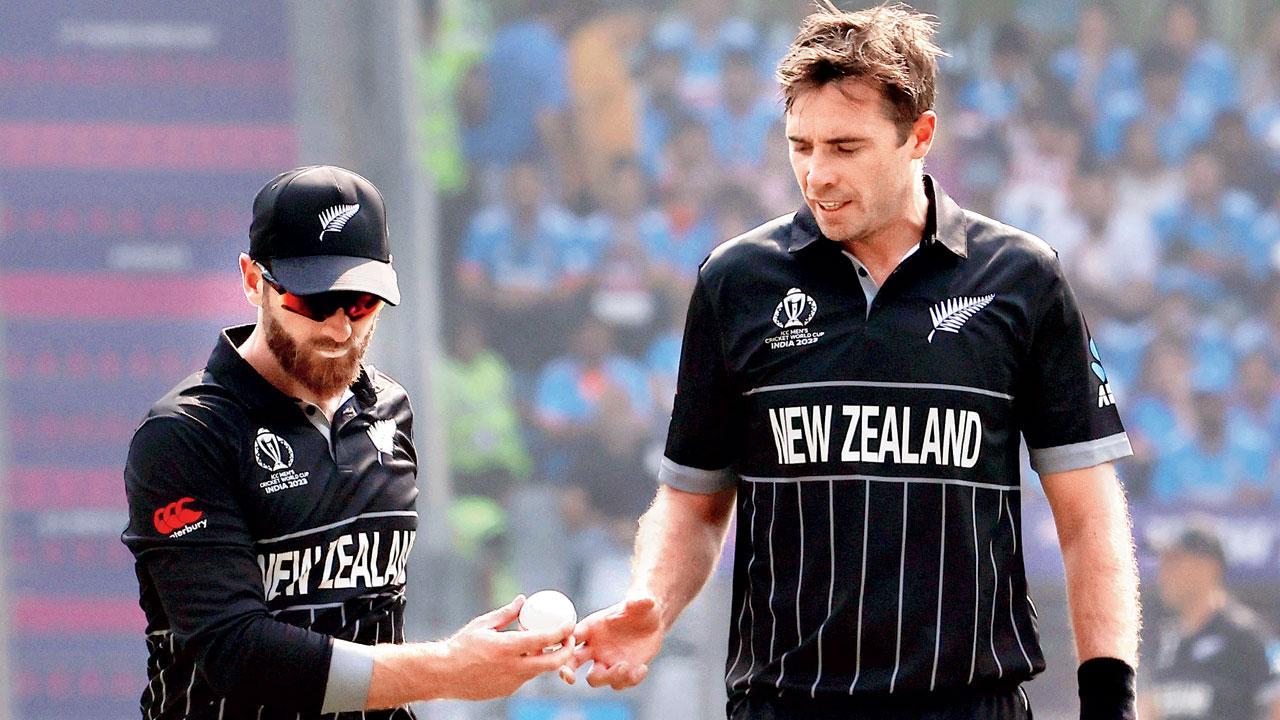Over the years, the Kiwis built a reputation for their planning and execution, discipline and self-control. The quicks will be disappointed with their efforts

New Zealand captain Kane Williamson (left) hands the ball to his fast bowler Tim Southee, who gave away 100 runs in his 10 overs at the Wankhede Stadium yesterday
Conceding 397 in 50 overs is not a problem. The problem is when you could see it coming from a mile away. In their last five matches, New Zealand have bowled first on four occasions and barring their final round robin game against Sri Lanka, they have conceded totals of 388 against Australia in Dharamsala, 357 against South Africa in Pune, and 397 against India in Mumbai.
ADVERTISEMENT
The Black Caps have paid a heavy price for their inability to break partnerships in this World Cup. In Dharamsala, Travis Head and David Warner put on 175 for the first wicket followed by Quinton de Kock and Van Der Dussen putting on 200 for the second wicket in Pune.
Also Read: ICC World Cup 2023 | SA vs AUS: Here's all you need to know
Babar and Fakhar’s stand
In Bangalore, it was Babar Azam and Fakhar Zaman who put on an unbeaten stand of 194 for the second wicket, whereas in Mumbai it was the trio of Shubman Gill, Virat Kohli and Shreyas Iyer who put on a whopping 256 runs for the second wicket. Wickets in any form of the game are like gold. You don’t pick them, and you will remain a pauper.
The three quicks Trent Boult, Tim Southee and Lockie Ferguson bowled 28 overs between them and picked up four wickets for 251 runs at an economy of 8.96. If the remaining 22 overs had gone for a similar economy rate, India would have made 448. Thankfully, the spinners led by Mitchell Santner (10-1-51-0) and supported by Glenn Phillips and Rachin Ravindra combined to bowl 22 overs for 144 runs ie an economy rate of 6.55. The quicks picked up wickets but when they come at 8.96 runs per over, they aren’t worth much.
Also Read: ICC World Cup 2023 | SA vs AUS: Players to score most runs
Poor discipline, execution
Over the years, New Zealand have built a reputation for their planning and execution, discipline and self-control. The bowlers, especially the quicks will be disappointed with their efforts on Wednesday.
The width offered along with the inconsistent lengths were an invitation for a run feast and we know how hungry the Indian batting line-up currently is. They said Bon Appetit with glee. White-ball cricket is a batter’s game. Thicker bats, flat pitches, lightning quick outfields, small boundaries, two new balls and three powerplays—all designed with the intention of increasing the boundary count.
Yes, it’s not fair how heavily skewed it is in favour of the willow, but it’s the same for every team. You can either whine and moan or you can improve your skill set to such a level, where regardless of the various parameters you still pick up wickets. This bowling performance left the New Zealand batters a Herculean task in a must win game. Remember, the age-old saying, “batters win you matches, bowlers win you tournaments.”
 Subscribe today by clicking the link and stay updated with the latest news!" Click here!
Subscribe today by clicking the link and stay updated with the latest news!" Click here!







